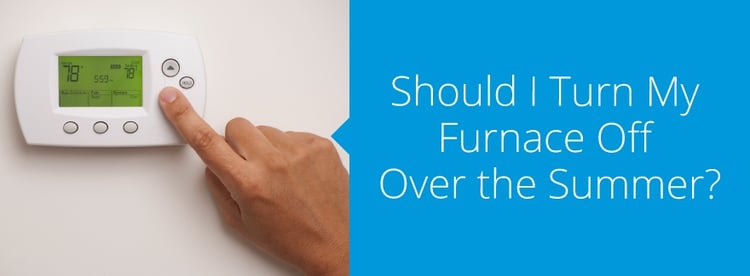
It’s undeniable — residents of the northeastern United States love the reliability of their oil furnaces. Homes in the Northeast use around 87% of all the heating oil consumed each year across the U.S. And with the efficiency of oil furnaces, it’s understandable.
Few feelings compare to walking into your warm house, with its efficient oil furnace, away from the piercing wind-chills and snowy winter weather outside. And when you’re the master of your home’s thermostat, the feeling is even better.
Once the snow melts, however, and the flowers begin blooming, you probably stop thinking about your oil furnace over the next five or six months and instead focus on that upcoming summer vacation. But maybe you should think about your oil furnace — it could save you money!
- What Type of Oil Furnace System Do You Have?
- How Your Oil Furnace Works
- Why Oil Furnaces Burn Fuel in the Summer
- What You Risk By Turning Off Your Oil Furnace
- What You Save by Turning Off Your Oil Furnace
- How to Turn Your Oil Furnace Off for the Summer
- How to Maintain Your Oil Furnace Over the Summer
- How to Turn Your Oil Furnace on for Fall
- How to Make Your Oil Furnace More Energy-Efficient
- Should You Turn Your Furnace Off?
Traditional oil furnaces burn seven days a week, 365 days a year, which is why many homeowners are beginning to ask, “Should I turn my furnace off over the summer?” The answer isn’t a simple “yes” or “no,” however. It’s based on several factors, like your type of oil furnace and its household use, as well as your personal preferences.
What Type of Oil Furnace System Do You Have?
You may remember this distant conversation when shopping for your oil furnace, or perhaps when walking through the open house for what is now your home. Knowing what type of oil furnace system you have, while a dry topic, is an essential step towards deciding if you should turn your furnace off in the spring.
Every oil-fired heating system contains an oil tank, a flue pipe and a thermostat. Systems differ by how they deliver or disperse heat throughout your house.
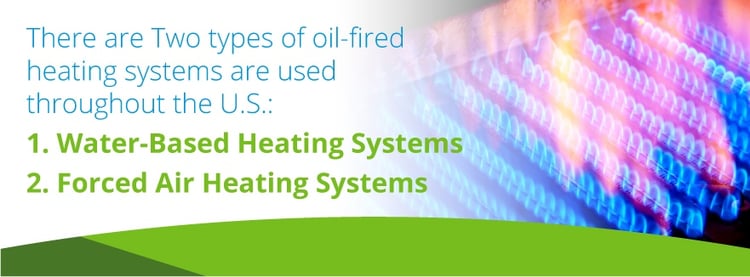
Two types of oil-fired heating systems are used throughout the U.S.:
- Water-Based Heating Systems: These provide heat to your home as either water or steam via your radiators, baseboard heaters or radiant floor heating. These systems are also called Hydronic Systems and rely on a boiler.
- Forced Air Heating Systems: These disperse heat throughout your home as warm air via your home’s floor and wall vents. The system is also known as a Warm Air System and uses a furnace. Forced Air Heating Systems are the more common of the two oil-fired systems.
Each of these systems, of course, receives its power from your oil tank and its set output from your thermostat’s designated temperature. Combustion from Warm Air and Water-Based Heating Systems exits through your flue pipe to your chimney.
Because oil-fired heating systems link to a thermostat, many homeowners wonder if the furnace is on and running during the summer when the thermostat is turned down. The answer, generally, is “yes.”
How Your Oil Furnace Works
Your furnace is working and burning fuel throughout the year, even when the temperatures outside are in the 80s and your home is a crisp 65 to 70 degrees Fahrenheit. Knowing how your oil furnace works is a stepping stone to understanding why it’s burning oil throughout the summer, even with your thermostat turned down.
Water-Based and Forced Air Systems work differently, as Water-Based Heating Systems rely on a boiler and Forced Air Systems use a furnace. How each of these oil-heating systems work is detailed below
Water-Based Heating Systems
Recall that Hydronic Heating Systems use water or steam to heat your home via a boiler. Hydronic Heating Systems divide into two operating methods, based on whether they’re delivering water or steam. The two approaches are Hot Water Systems and Steam Systems.
Hot Water Systems deliver heat in eight steps:
- The thermostat senses a drop in room temperature and sends a signal to your Hot Water System.
- The oil burner engages and begins drawing heating oil from your fuel tank.
- The oil passes through a tube, where it becomes a mist by mixing with air.
- The fuel mixture enters the oil burner and ignites in the combustion chamber.
- The cast iron or steel boiler draws and begins to heat the water.
- The hot water is pumped and circulated through your radiators or baseboard heaters.
- The emissions exit through the flue pipe and chimney.
- The cooled water returns to the boiler and is reheated.
Steam Systems follow the first four steps as Hot Water Heaters, but differ at the start of the fifth stage. Instead of heating the water until it’s warmed, Steam Systems boil the water to create steam. The steam then rises through pipes connected to your home’s radiators and heats your home.
Forced Air Heating Systems
Forced Air Heating Systems match the initial four steps, as you’ll see, of Hydronic Heating Systems. It’s at the fifth step where things diverge:
- The thermostat signals to your oil burner a drop in your home’s temperature.
- The oil burner reacts and pulls heating oil from your tank.
- The oil combines with an air mixture and becomes a mist.
- The mist reaches the oil burner and ignites a flame.
- The return ducts pull cold air in from your home and heat it.
- The oil burner’s blower pushes the warmed air into feed ducts.
- The feed ducts deliver the air through wall and floor vents.
- The oil burner’s emissions exit via the flue pipe and your chimney.
You understand how your oil-fired heating system works, but why would it be running during the summer? Because your thermostat is lowered and because your heating system receives signals from your thermostat, it would make sense that your furnace would hibernate in the summer. But it doesn’t.
Why Oil Furnaces Burn Fuel in the Summer
So — why is your oil furnace or boiler burning fuel throughout the summer months? Three reasons can cause furnaces to burn fuel during the warmer months, and neither is an error or hardware fault:
- The age of your furnace or boiler. Older furnaces, around 15 years or more, feature the time-tested and reliable pilot light. A pilot light is lit 24 hours a day, seven days a week.
 If you go down to your boiler or furnace, you’ll see a tiny blue flame — that’s your pilot light. If your pilot light goes out, whether from a broken piece of hardware or clogged fuel line, your furnace won’t work.
If you go down to your boiler or furnace, you’ll see a tiny blue flame — that’s your pilot light. If your pilot light goes out, whether from a broken piece of hardware or clogged fuel line, your furnace won’t work.
A pilot ignition system’s initial purpose was to save people time. The furnace could generate heat automatically, without being manually lit by members of the household. The result, however, was an inefficient oil furnace that is still used in older homes. And the inefficiencies of these furnaces extend beyond their summer use of your heating oil, but also their production of heat.
The Annual Fuel Utilization Efficiency (AFUE) of these older furnaces is 56 to 70%, which means only 56% of the energy from the oil becomes heat for your home. In comparison, modern systems offer AFUE rates of 80 to 98.5%. The heat lost by these pilot light furnaces doesn’t give you a full return on the heating oil you purchase, but wastes it instead.
Modern systems have a higher AFUE due to hardware changes. Modern oil furnaces for your home, for example, have a sealed combustion to lower their losses during cycling. They also have an electronic ignition, not a pilot light. Electronic ignitions allow your furnace to start without maintaining a flame to ignite the oil. These ignitions are a major contributor to the increased efficiency of newer furnaces.
- The use of your boiler as a water heater. Using boilers as water heaters is common, and it’s often convenient for households. The hardware used to outfit boilers to heat water, however, can cause your boiler to demand more energy throughout the summer days.
Tankless coils are often used by boilers to heat water. The fault with these coils is that they demand your boiler be hot, which isn’t a problem in the winter. The summer, however, makes your boiler turn off and on every time you want a bit of warm water.
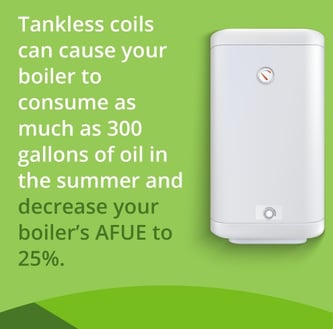 Tankless coils can cause your boiler to consume as much as 300 gallons of oil in the summer and decrease your boiler’s AFUE to 25%. Indirect water heaters are more energy-friendly than tankless coils. In this system, you have a separate water tank that’s heated by the boiler and stores hot water for you to use. Indirect water heaters prevent your boiler from constantly cycling on and off in the summer, so your boiler runs less often.
Tankless coils can cause your boiler to consume as much as 300 gallons of oil in the summer and decrease your boiler’s AFUE to 25%. Indirect water heaters are more energy-friendly than tankless coils. In this system, you have a separate water tank that’s heated by the boiler and stores hot water for you to use. Indirect water heaters prevent your boiler from constantly cycling on and off in the summer, so your boiler runs less often.
- The role of your furnace in cooling systems. New and old furnaces can both be used in your home’s cooling system. Some households opt to have their central air conditioning system work with their furnace to keep their house cool. If you use window units, your furnace is not cooling your home.
In central air conditioning systems, your furnace powers an outdoor compressor and AC evaporator coil. The compressor keeps the evaporator coil cool with refrigerant to remove heat and humidity from your home. Your furnace’s blower then spreads the cold air from the coil throughout your home.
Knowing why your furnace is burning fuel in the summer is key to determining if you should turn it off over the summer. If you use it as a water heater or as a support to your central air system, shutting it down for five to six months isn’t an option without changes to your current setup.
What You Risk by Turning Off Your Oil Furnace
If you have a furnace with a pilot light, you’re probably ready to blow out or turn off your furnace’s pilot light for the summer. Turning off your oil furnace or boiler for the summer, however, has some risks:
- Moisture is the greatest threat to an inactive boiler. Because your boiler is shut off and inactive, it becomes cool, which makes it a prime location for water to condense, especially if your basement is prone to being damp in the summer. The gathering of moisture causes rust and can lead to you replacing your boiler sooner, rather than later.
- Corrosion is common in shut-down furnaces. Furnaces are prone to corrosion from water and soot when they’re shut off during the summer. Even without moisture, a buildup of soot can cause the walls of your furnace and boiler to corrode and shorten its life expectancy.
- Debris is prone to gathering in unused oil tanks. Inactive furnaces and boilers encourage insects and spiders to take up residence in your fuel tank, as well as the fill and vent pipes leading into and out of your oil tank. If a substantial amount of debris gathers in your tank or pipes, it can prevent fuel from flowing to your furnace when you turn it on in the fall. Fixing the problem involves draining and cleaning your tank.
Many of these risks are avoidable, however. Cleanings scheduled before you turn off your furnace in the spring can prevent corrosion from rust while topping off your tank beforehand can deter insects from moving in and creating debris.
Combatting moisture is more of a challenge, especially with boilers. Keep the area ventilated to try and reduce condensation. Another tactic is turning on your boiler once a month throughout the summer, so it can heat up and evaporate any moisture.
Before turning off your furnace for the summer, weigh the risks or even talk to an HVAC technician from your heating oil supplier to find out their recommendations or advice about turning off furnaces during the warmer months.
What You Save by Turning Off Your Oil Furnace
If you decide to turn off your home furnace in the spring, you’ll gain a few benefits throughout the following months. Depending on your type of furnace or boiler, your savings may be greater than others.
Benefits from turning off your oil furnace include:
- Lowered energy costs. Pilot light ignition systems raise your energy bill by $30 to $40 each year. Turning off your furnace and its pilot light can result in monthly savings of $2 to $4 — enough to treat yourself to a cup of coffee.
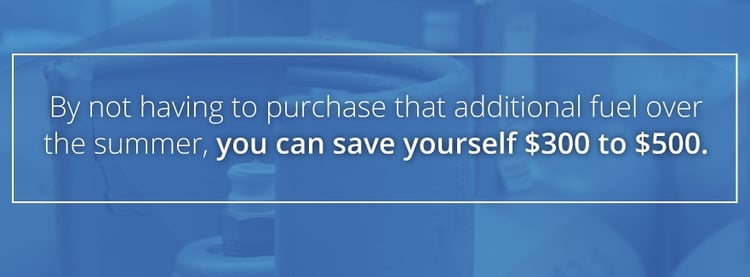
- Decreased fuel usage. Inactive boilers, especially ones previously used as your home’s water heater, will save your oil tank 200 to 300 gallons of fuel in the summer alone. By not having to purchase that additional fuel over the summer, you can save yourself $300 to $500.
- Reduced noise. Furnaces are often located in the basement, with one reason being the noise from the blower. While not a financial benefit, it’s one you’ll notice throughout the summer and when you turn your furnace back on in the fall.
Over time, you can calculate the exact savings, whether through energy or fuel costs, of turning off your furnace in the spring. Use your experience to decide if you want to continue turning your furnace or boiler off over the summer or keep it on throughout the year.
How to Turn Your Oil Furnace Off for the Summer
Turning your furnace off for the summer is a straightforward process. Review your furnace and oil tank manual before proceeding with shutting it off. While many furnaces follow the same approach, yours may differ.
If you’re turning off a furnace with a pilot light, you’ll follow these five steps:
- Lower the thermostat to its lowest setting.
- Wait for the furnace to stop its heating cycle.
- Flip the furnace power switch to “Off.”
- Twist the pilot light shut-off valve clockwise to cut off its oil supply.
- Turn the fuel tank’s main shut-off valve clockwise to turn it off.
Furnaces without a pilot light have a simpler series of steps:
- Lower the thermostat to its lowest setting.
- Wait for the furnace to stop its heating cycle.
- Turn the furnace’s power switch to “Off.”
- Twist the oil tank’s fuel shutoff valve clockwise to shut it off.
Furnaces and boilers can shut down without following these steps by using the emergency shutoff switch. Your home likely includes two of these switches. One by the boiler or furnace and a second by the nearest stairwell. If your heater is in your basement or cellar, for example, you’ll find the emergency shutoff switch at the top of your basement’s stairway.
It’s recommended, though, that you turn off your oil heating system using the steps listed above instead of relying on the emergency shutoff switch. It’s a great way to build familiarity with your heating system, as well as an opportunity to ensure the hardware is functioning.
How to Maintain Your Oil Furnace Over the Summer
Maintenance is essential to reducing your risks when turning your furnace off in the spring. It’s also a key factor in extending the life and improving the overall efficiency of your furnace or boiler.
You can maintain your furnace throughout the year, in addition to scheduling a professional inspection and cleaning by an HVAC technician:
- Personal Maintenance: Look over and inspect your furnace throughout the year. Keep an eye out for soot or any signs of rust. Excessive soot can signal that your furnace is burning more fuel than necessary. Dark chimney smoke is also a sign of this.
Dust and clean your furnace when you turn it off. Allergens and burned dust particles can build up and spread throughout your home in Forced Air Heating Systems.
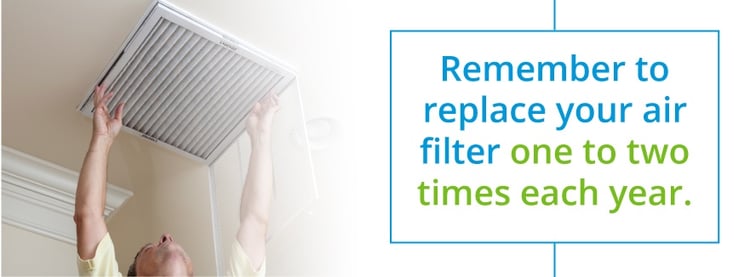
Dust also gathers in your furnace’s air filter, so remember to replace your air filter one to two times each year.
Fill your fuel tank before shutting off your furnace and use an additive like Hot Shot, which breaks down sludge that’s formed from water and air in the oil tank. Both practices will reduce your chance of debris and potential difficulties in restarting your furnace.
- Professional Maintenance: Schedule a professional maintenance appointment at least once a year, whether you shut down your furnace or not. Try to plan it either in the spring or at the end of the summer. Avoid waiting until the fall as it’s often a busy time for technicians.
Technicians will clean your furnace or boiler’s combustion chamber, which can fill with soot and water, to prevent rust and corrosion. They’ll also inspect the chamber to ensure no holes have formed. The flue pipe will also be checked for corrosion and holes.
HVAC experts will install new oil and air filters, as well as test your burner’s efficiency and make any necessary adjustments. Technicians also vacuum floor vents, though you’re welcome and encouraged to do this throughout the year — especially if you have pets.
Take a proactive approach when it comes to your furnace’s maintenance. Investing in your furnace and boiler through routine maintenance can increase your heater’s life expectancy, as both furnaces and boilers can last 15 to 30 years. Your investment also lowers your risks when turning off your furnace in the spring.
How to Turn Your Oil Furnace on for Fall
If you turned off your furnace in the spring and over the summer, you might forget when fall rolls around that you even shut it off. To turn you oil furnace on for the winter, you can either flip your emergency shut-off switch back to “On” or follow these steps:
- Ensure your oil tank is full.
- Move the oil tank’s shut-off valve counterclockwise to turn it on.
- Flip the furnace’s power switch to “On.”
Furnaces with pilot lights will need their shut-off valve turned on by moving the valve counterclockwise. When on, the valve will be parallel to the fuel line below it. You’ll then need to hold down the bypass button on the furnace and re-light the pilot flame.
Ask for help while re-lighting the pilot flame. Hold down the bypass button and have a friend or family member light the pilot flame with a lighter or match. Keep pressing down on the bypass button for 30 seconds after the pilot flame is ignited and then release.
Once your furnace is on, you can go back to enjoying your home’s warm embrace throughout the winter months.
How to Make Your Oil Furnace More Energy-Efficient
Turning off your oil furnace over the summer can reduce your energy costs, but if you choose not to or are unable to, there are other ways you can increase your furnace or boiler’s energy-efficiency.
Retrofitting is a common approach to making older oil-fired furnaces and boilers more energy-efficient. Retrofits include:
- Flue dampers to prevent chimney losses. Flue dampers are available in either vent or barometric dampers. These dampers close off your boiler’s vent when it isn’t firing, boosting your AFUE rating and increasing your boiler’s efficiency.
- Replacement oil burners to reduce fuel use. Replacement burners, like a flame retention burner, can block air from escaping through your chimney. The burner can save you up to 20% on fuel costs or around $500. Derating or down-firing is another way to reduce fuel use. Derating installs a lower gallon-per-hour nozzle in your combustion chamber that limits excessive fuel use.
- Modulating aquastats to stop continuous cycling. Aquastats help stop the constant cycling of boilers with tankless coils. A modulating aquastat adjusts the needed temperature of hot water by monitoring outdoor temperatures. The result is a 10% reduction in fuel costs.

- Time-delay relays to keep boilers inactive. Time-delay relays are a cost-effective retrofit for keeping boilers from continuously running as hot water heaters. The attachment makes your boiler circulate hot water through the system before turning on after a designated amount of time. Save up to 10% on your household’s fuel costs with time-delay relays.
In some cases, based on your boiler or furnace’s age, retrofitting may not be the best option. You’ll want to weigh the cost of the retrofits in comparison to the cost of a new furnace or boiler, as well as the potential savings of a more energy-efficient oil heater, to decide about replacing or updating your furnace.
Should You Turn Your Furnace Off?
Whether you choose to turn off your furnace in the spring or keep it on over the summer is up to you. Neither option is wrong or right. Make your decision by considering the risks and benefits, as well as your boiler and furnace’s unique features and factors.
And if you’re unsure about turning your furnace off over the summer, you’re welcome to contact our experienced team at SmartTouch Energy for helpful advice that comes from more than 85 years of experience of serving and providing energy across the Northeast.
If you’ve already decided to turn off your furnace over the summer, check out our oil burner cleaning services as well as our competitive home heating oil prices to prep your furnace for its summer hibernation.




